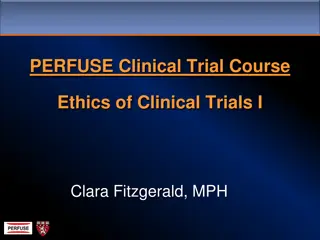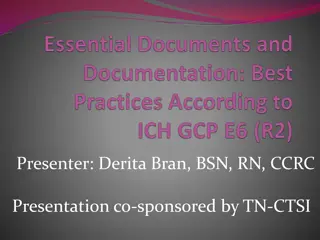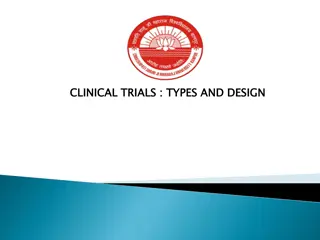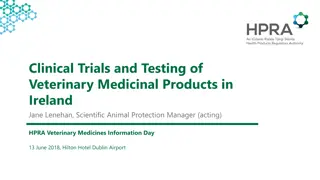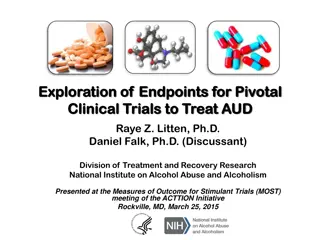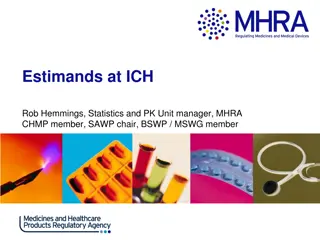
Understanding Clinical Trials: NIH Definition, Conduct, and Reporting Guidelines
Explore the NIH definition of clinical trials, learn the importance of registering trials before enrollment, and understand the CONSORT statement checklist for reporting clinical trial results effectively. Conducting a clinical trial involves prospectively assigning human subjects to interventions to evaluate health-related outcomes.
Download Presentation

Please find below an Image/Link to download the presentation.
The content on the website is provided AS IS for your information and personal use only. It may not be sold, licensed, or shared on other websites without obtaining consent from the author. If you encounter any issues during the download, it is possible that the publisher has removed the file from their server.
You are allowed to download the files provided on this website for personal or commercial use, subject to the condition that they are used lawfully. All files are the property of their respective owners.
The content on the website is provided AS IS for your information and personal use only. It may not be sold, licensed, or shared on other websites without obtaining consent from the author.
E N D
Presentation Transcript
Conducting a Clinical Trial Clinical Research vs Clinical Trial
Clinical Trial NIH Definition A research study in which one or more human subjects are prospectively assigned to one or more interventions1 (which may include placebo or other control) to evaluate the effects of those interventions on health-related biomedical or behavioral outcomes2. 1 drugs, biologics, devices, procedures (e.g., surgical techniques); delivery systems (e.g., telemedicine); strategies to change health-related behavior (e.g., diet, exercise); treatment, prevention, diagnostic strategies 2physiological or biological parameters (e.g., VO2peak, gene expression); changes to psychological or neurodevelopmental parameters; changes to disease processes; changes to health-related behaviors; changes to quality of life.
Clinical Trial NIH Definition grants.nih.gov/policy/clinical-trials/definition.htm 1. Does the study involve human participants? 2. Are the participants prospectively assigned to an intervention? 3. Is the study designed to evaluate the effect of the intervention on the participants? 4. Is the effect being evaluated a health-related biomedical or behavioral outcome? 4 YES answers = clinical trial small or large mechanistic or therapeutic exploratory or confirmatory
Conducting a Clinical Trial Determining whether your study is considered a clinical trial before it begins is very important. Clinical trials must be registered, typically at: ClinicalTrials.gov Must register BEFORE the first volunteer is enrolled Many journals will not publish results if the trial was not registered Manuscripts may need to follow the CONSORT guidelines (consort-statement.org)
CONSORT Statement 2010 Checklist CONSORT Statement 2010 Checklist Items to include when reporting results from a clinical trial PAPER SECTION and topic TITLE & ABSTRACT Item Descriptor 1 How participants were allocated to interventions (e.g., "random allocation", "randomized", or "randomly assigned"). Scientific background and explanation of rationale. 2 INTRODUCTION Background METHODS Participants Interventions 3 Eligibility criteria for participants and the settings and locations where the data were collected. Precise details of the interventions intended for each group and how and when they were actually administered. Specific objectives and hypotheses. Clearly defined primary and secondary outcome measures and, when applicable, any methods used to enhance the quality of measurements (e.g., multiple observations, training of assessors). How sample size was determined and, when applicable, explanation of any interim analyses and stopping rules. 4 5 6 Objectives Outcomes 7 Sample size
CONSORT Statement 2010 Checklist CONSORT Statement 2010 Checklist Items to include when reporting results from a clinical trial PAPER SECTION and topic Randomization -- Sequence generation Randomization -- Allocation concealment Randomization -- Implementation Blinding (masking) Item Descriptor 8 Method used to generate the random allocation sequence, including details of any restrictions (e.g., blocking, stratification) 9 Method used to implement the random allocation sequence (e.g., numbered containers or central telephone), clarifying whether the sequence was concealed until interventions were assigned. Who generated the allocation sequence, who enrolled participants, and who assigned participants to their groups. Whether or not participants, those administering the interventions, and those assessing the outcomes were blinded to group assignment. If done, how the success of blinding was evaluated. Statistical methods used to compare groups for primary outcome(s); Methods for additional analyses, such as subgroup analyses and adjusted analyses. 10 11 12 Statistical methods
CONSORT Statement 2010 Checklist CONSORT Statement 2010 Checklist Items to include when reporting results from a clinical trial PAPER SECTION and topic RESULTS Participant flow Item Descriptor 13 Flow of participants through each stage (a diagram is strongly recommended). Specifically, for each group report the numbers of participants randomly assigned, receiving intended treatment, completing the study protocol, and analyzed for the primary outcome. Describe protocol deviations from study as planned, together with reasons. Dates defining the periods of recruitment and follow-up. Baseline demographic and clinical characteristics of each group. 14 15 Recruitment Baseline data 16 Number of participants (denominator) in each group included in each analysis and whether the analysis was by "intention-to-treat". State the results in absolute numbers when feasible (e.g., 10/20, not 50%). Numbers analyzed
CONSORT Statement 2010 Checklist CONSORT Statement 2010 Checklist Items to include when reporting results from a clinical trial PAPER SECTION and topic Outcomes and estimation Item Descriptor 17 For each primary and secondary outcome, a summary of results for each group, and the estimated effect size and its precision (e.g., 95% confidence interval). Address multiplicity by reporting any other analyses performed, including subgroup analyses and adjusted analyses, indicating those pre-specified and those exploratory. All important adverse events or side effects in each intervention group. Interpretation of the results, taking into account study hypotheses, sources of potential bias or imprecision and the dangers associated with multiplicity of analyses and outcomes. Generalizability (external validity) of the trial findings. General interpretation of the results in the context of current evidence. 18 Ancillary analyses 19 Adverse events DISCUSSION Interpretation 20 21 22 Generalizability Overall evidence
Data management some issues are unique to clinical trials, some are common to all research Accessing clinical records, getting results from clinical labs (HIPAA issues) HIPAA involves privacy/confidentiality AND security Database must have audit trails and transaction logs Paper (ePaper) trails documentation Missing data system for knowing when they are not collected versus collected but not in the database Fidelity system for verifying data accuracy
Develop the database BEFORE the study begins Create a Data Dictionary that defines and categorizes (e.g., primary, secondary, descriptive) all variables If data will be merged from multiple sources, make sure common elements have the same variable name and format If possible, engage both a data manager (handles front end issues how to get data IN) and a data analyst or biostatistician (handles back end issues how to get data OUT) from the outset Use electronic data transfer rather than manual entry whenever possible Use a CTMS (e.g., OnCore, Click Commerce)
Regulatory oversight IRB essential DSMB often required Each NIH I/C has its own requirements Responsibilities of a DSMB Approve protocol and DSMB Charter Monitor recruitment, enrollment, retention Monitor adverse events Make recommendations regarding protocol changes, whether the study should continue, etc
Investigator DSMB-related responsibilities Develop a DSMB charter that defines DSMB responsibilities, defines specific criteria for individual- and study-stopping rules, defines when the DSMB will review unblinded data Report AEs Report protocol changes Generate progress reports that include essential information in an easy-to-read format Preparation for progress reports includes closing datebase to data entry, data scrubbing, compilation DO THE WORK FOR THEM
Accrual Timeline 4 Award Month Projected accrual randomization retention completion 1 2 3 5 6 7 8 9 10 11 12 3 3 24 6 6 36 9 9 48 12 11 60 15 14 72 18 16 84 21 19 96 24 22 108 27 25 124 31 28 3 136 34 30 6 Jul 2008 12 Mar 2008 171 18 18 Actual accrual randomization retention completion 21 26 41 43 6 6 51 10 10 87 13 13 154 13 13 246 22 22 293 24 24
Cumulative Recruitment/Enrollment Activity: Ethnic and Racial Breakdown Screened Unknown Women Men Total Oriented Men Randomized Women Projected Men Women Total Men Total Women Total Ethnic Categories Hispanic or Latino Not Hispanic or Latino Unknown Ethnic Categories: Total 5 9 14 332 2 59 0 61 2 44 0 46 4 2 30 0 32 1 19 0 20 3 49 0 52 13 62 0 75 13 62 0 75 26 124 0 150 214 118 103 0 107 7 7 23 242 6 36 382 133 Racial Categories American Indian/Alaskan Native Asian 0 1 1 2 1 3 0 0 1 0 1 0 0 0 1 0 1 0 1 2 1 2 2 4 Native Hawaiian/Pacific Islander Black or African American White More than one race Unknown Racial Categories: Total 1 14 200 2 24 242 0 9 1 23 314 3 37 382 0 4 54 3 0 61 0 2 43 0 0 46 0 6 97 3 0 107 0 3 27 2 0 32 0 0 19 0 0 20 0 3 46 2 0 52 0 4 68 0 0 75 0 4 68 0 0 75 0 8 114 1 6 133 136 0 0 150 7 7
Disqualifications Reason for Disqualification osteoporosis osteoporosis orthopedic problems hypertension hypertension hypertension positive stress test aspirin use heart disease osteoporosis osteoporosis hemoglobin multiple medical issues unrepaired hernia creatinine clearance heart disease osteoporosis ID 18009 18013 18021 18023 18024 18033 18041 18042 18070 18079 18080 18081 18104 18110 18123 18129 18130
Progress of Enrolled Participants ID exercise start date date of tri-monthly clinician visit 6 2/6/08 dropped 2/15/08 5/23/08 2/22/08 6/2/08 2/11/08 5/27/08 lost to follow-up reason 3 9 18001 18004 18006 18008 18010 18011 18014 18015 18016 18017 18018 18019 18022 18025 18026 11/12/07 11/20/07 11/26/07 11/13/07 7/17/08 11/16/07 1/15/08 11/27/07 12/4/07 12/18/07 12/11/07 12/11/07 1/18/08 1/30/08 4/18/08 refused to continue 8/22/08 8/25/08 8/12/08 2/11/08 4/10/08 2/25/08 2/26/08 3/6/08 3/17/08 3/17/08 4/17/08 5/5/08 on hold 5/23/08 7/23/08 5/29/08 7/17/08 7/22/08 6/24/08 6/24/08 7/22/08 8/13/08 8/18/08 8/14/08 9/15/08 8/6/08 8/6/08
Inclusion criteria for volunteers who were randomized SBP DBP AST ALT Cr clr K TSH Hb (W) HbA1c total hip L1-L4 Included if: <150 mmHg <90 mmHg <70 U/L <70 U/L >50 mL/min <5 >12.1 g/dL <7 % >-2.5 t-score >-2.5 t-score 0.5 and 5.0 mU/L mmol/L ID SEX Female Female Female Female Female Female Female Female Female Female Female Female 18001 18004 18006 18008 18010 18011 18016 18017 18018 18025 18026 18028 131 137 95 102 126 128 99 117 120 143 122 150 79 81 72 57 65 52 64 73 65 81 58 76 20 22 18 28 24 25 22 23 21 22 26 20 17 35 20 25 23 22 17 24 17 25 35 20 4.2 3.6 3.7 3.8 3.4 3.7 3.5 3.8 3.7 4.7 3.9 3.8 1.4 1.6 1.1 1.3 0.8 1.0 1.3 0.8 1.5 2.4 2.8 2.9 15.5 15.1 14.4 13.6 14.1 14.6 14.8 16.0 14.8 15.0 13.3 13.1 5.7 6.1 5.5 5.4 5.5 6.3 5.8 5.7 5.3 6.0 7.0 5.6 -1.2 0.7 -0.7 0.3 0.6 -0.3 -0.4 -0.5 0.4 -0.9 -1.0 -1.3 -1.8 1.3 -1.6 0.3 0.1 -0.9 -0.9 -0.7 0.0 -2.1 -2.0 -1.5 73.4 55.3 97.3 68.1 84.1 81.9 57.6 116.9 78.5 77.5 158.8 80.2
Safety Data - Hemoglobin trigger: Hb below sex-specific concentrations or >3 g/dL drop from baseline Months 6 9 6 9 0 0 3 3 0 0 3 3 Women <10.1 g/dL Men <12.3 g/dL ID ID 18001 15.5 14.3 18014 14.5 15.6 14.6 18004 15.1 15.0 14.5 14.1 18015 16.9 16.3 16.8 16.4 18006 14.4 13.9 14.4 14.2 18019 15.9 14.6 15.0 18008 13.6 13.6 13.9 13.8 18022 15.8 15.8 15.4 18010 14.1 18029 17.4 18011 14.6 14.3 13.4 10.4 18032 16.2 18016 14.8 14.7 15.0 18036 17.4 16.5 18017 16.0 16.1 15.5 18043 14.6 18018 14.8 13.8 14.2 18044 16.0 18025 15.0 15.0 18046 16.8 15.3
Adverse Events/Complaints Serious 0 0 Non-serious 46 22 Number of events Number of subjects exercise intervention- related 11 11 procedure-related 1 1 other 36 17 Number of events Number of subjects Endocrine 1 1 Hyperglycemia Pulmonary 1 1 Other Musculoskeletal 11 1 12 1 1 7 2 Myalgia Arthralgia Sprain/strain Contusion Muscle cramp 4 4 1 1 2 Other 1 Infection 15 1 10 4 UTI URI/ Viral Syndrome Other Gastro-intestinal 5 4 1 Abdominal pain Diarrhea/constipation Neurology 1 1 Fall Gynecological 1 1 Other
Eligibility criteria- BE SPECIFIC Hypertension Uncontrolled hypertension Uncontrolled hypertension, defined as SBP>150 mmHg or DBP>90 mmHg Uncontrolled hypertension, defined as SBP>150 mmHg or DBP>90 mmHg; 3 repeat evaluations will be allowed Uncontrolled hypertension, defined as SBP>150 mmHg or DBP>90 mmHg; 3 repeat evaluations will be allowed; if initiation or adjustment of drug treatment is necessary, volunteer will be re- evaluated after 6 weeks Have an eligibility checklist with double sign-off
Intent-to-treat versus On-treatment Analysis Intent-to-treat approach Results are based on initial treatment assignment and not on treatment received Avoids misleading results if there is non-random attrition Participants should be retained in the trial even if they do not adhere to treatment Investigator can withdraw a participant from treatment but not from the study
Intent-to-treat versus on-treatment analysis On-treatment approach Also known as compliance, sensitivity, or per-protocol analyses Analysis includes only participants who were compliant to the intervention Must have a way to measure exposure Must define compliance at the outset For drug trials, compliance is typically considered taking 80% to 120% of prescribed doses Analogous criterion for exercise intervention is attending at least 80% of prescribed sessions
Tracking tools How will you track: progress of individuals through an intervention? samples (obtained, in freezer, sent to lab, results returned, etc)? study charts that have to be passed around? Regulatory documents manual of procedures (detailed) standard operation procedures delegation log, training and competency certificates





